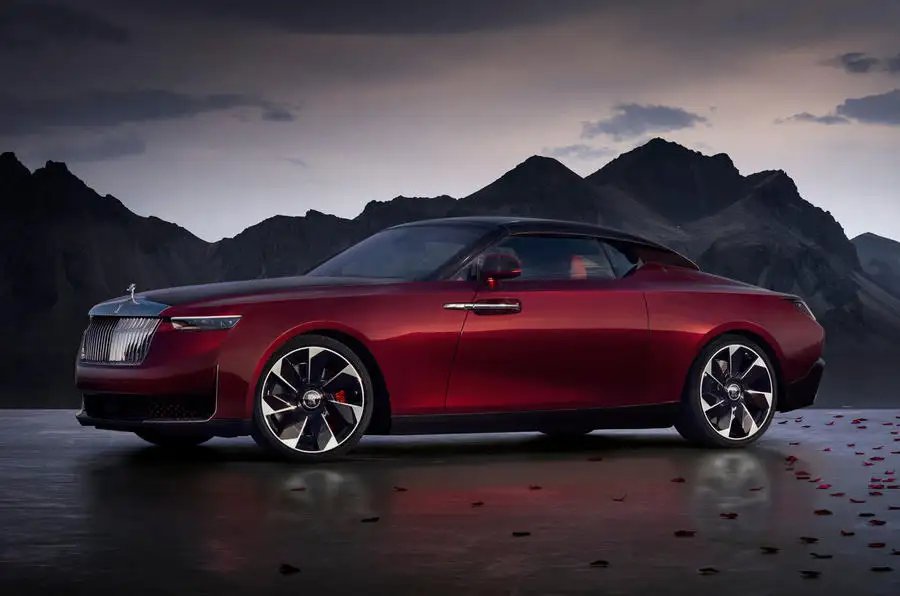Rolls-Royce Drop Tail revealed as ultra-limited two-seat roadster

The Rolls-Royce Drop Tail is the marque’s first modern two-seat roadster, harking back to the coachbuilt drop-tops that established it as a leading luxury brand a century ago.
The product of a four-year collaboration between Rolls-Royce and four clients, the firm said it represents the “absolute pinnacle” of its in-house coachbuilding capabilities, following in the footsteps of 2017’s Sweptail and 2021’s Boat Tail as the latest entry in a series of ultra-exclusive, multi-million-pound specials.
Rolls-Royce does not give prices for its coachbuilt specials, but each of the four Drop Tails is understood to have cost its owner more than the £20 million Boat Tail.
Rather than being simply a reworking of the now-retired Dawn convertible, the Drop Tail is underpinned by an all-new monocoque chassis constructed from steel, aluminium and carbonfibre, in a first for the Coachbuild division. It previously based bespoke models on the Architecture of Luxury platform, which is also used for the Cullinan, Ghost and Phantom.
Power is provided by the familiar twin-turbocharged 6.75-litre V12 in a bespoke state of tune that boosts power by 30bhp over the Phantom but cuts torque by 44lb ft, giving total outputs of 593bhp and 620lb ft. Rolls has not revealed any performance figures, but no doubt the Drop Tail will be a close match for the V12-engined Dawn, with a sub-5.0sec 0-62mph time and a top speed capped at 155mph.
Rolls-Royce design director Anders Warming told Autocar the V12 was used rather than an electric powertrain because the marque is “celebrating” the roadster “and the V12 is a powertrain we will be celebrating for the next couple of years”. He added that “time will tell” for electric coachbuilds.
At 5.3m long and 2.0m wide, it is smaller than the electric Spectre, with its completely bespoke silhouette defined by a low coupé-esque roofline inspired by ‘chop-top’ hot rods. This gives the new model a more overtly sporting character than mainstream Rolls-Royce models, reinforced by blade-shaped haunches and the large carbonfibre rear diffuser, finished in semi-clear lacquer to highlight how it juts out from the painted body.
The removable roof panel is carbonfibre, too, which makes it easier for the driver – or indeed their valet – to remove and replace it. It also features a large section of electrochromic glass, which tints and untints at the touch of a button.
Aerodynamics played an important role in shaping the Drop Tail. Rolls-Royce noted that its swooping rear end is “not ordinarily conducive to producing downforce”, which is to say that it was insufficiently stable at high speeds without external assistance. Rather than mount a spoiler, Rolls tweaked the design of the rear deck to produce the necessary downforce without compromising on aesthetics – a process that took two years and 20 iterations.
The Drop Tail’s front end design, meanwhile, is more familiar, although whereas the grille’s bars are typically straight and upright, they are curved on the Drop Tail and end at chamfered – rather than right-angled – corners. These adjustments reflect the car’s “informal spirit”, according to Rolls-Royce.
That ‘informal’ approach continues inside, where the brief was to create an “intimate” environment. Switchgear is obscured where possible. Only three buttons are left in open view, and the powered centre console can be moved to cover the infotainment control dial.
A vast wooden panel cocoons the seats, intended to reinforce the “romantic” atmosphere. It was built by a single craftsman – a former Rolls-Royce apprentice – who is said to have worked on the panel over nine months, in silence, for no more than one hour per day, to ensure complete focus on the task. This was the “most complicated, involved and prohibitive work of craft ever produced” at its Goodwood factory, said Coachbuild design boss Alex Innes.
The first Drop Tail, dubbed ‘La Rose Noire’, comes with a bespoke Audemars Piguet watch which also functions as the car’s clock, mounted to the dashboard using a clasp mechanism. This posed a significant challenge, said Innes: “That had to be crash tested, both physically and in virtual simulations, to ensure that the timepiece would remain in situ were the car to experience any sort of abstract movements in a crash situation. [We went to] lengths that nobody would normally go to, were they not instigated by the specific wishes of a commissioning client.”
La Rose Noire is said to have been commissioned by a husband and wife, who are the heads of a “prominent international family”.
It is inspired by their relationship, with ‘True Love Red’ paint and a darker shade dubbed ‘Mystery’. The interior’s wooden panel – made from black sycamore in reference to the car’s French provenance – is supposed to represent falling rose petals. “Even the leather was worked to include a sheen and a texture to its colour that would mimic the richness of the rose petals themselves,” said Innes.
To celebrate the car’s completion, the couple also commissioned an exclusive vintage of Champagne de Lossy. In turn, Rolls-Royce integrated a champagne chest into the car, featuring a set of hand-blown flutes.
Rolls-Royce CEO Torsten Müller-Ötvös said: “Drop Tail also answers a long-standing question – can a car be created as art? With the unveiling of this extraordinary roadster, the answer is, unequivocally, yes.”
Warming added that Coachbuild is “the ultimate expression of Rolls-Royce” and “the pinnacle of what [the marque] represents not only as far as aesthetics and beauty, but also as far as what can [possibly] be manufactured for a single car.”
